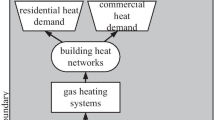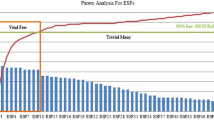Abstract
Project decisions are currently decided primarily on initial costs and neglect environmental and social aspects. In this study, a new optimization algorithm has been developed based on the three-legged stool of sustainability, namely technical, environmental, and socioeconomic aspects. The new algorithm, entitled the sustainability-based optimization algorithm, will minimize the average of normalized values of life-cycle costs, environmental impacts, and social objections subject to the constraint that all options will be acceptable. The optimal combinations of input variable values are found by optimization. The algorithm is demonstrated on algal biofuel production and is adapted from the model described in the greenhouse gases, regulated emissions, and energy use in transportation model. The indicators that are practical and widely applicable in algal production were based on previous studies. The results show the minimum objective function occurs at the combination of input variables that minimizes each component of sustainability, namely CO2-reduction, environmental, and economic aspects. The minimum objective considering only the social aspects occurs at the water-recycling reduction scenario. Considering the optimal solution with the focus only on one of the environmental, social, or economic terms could potentially lead to a solution that is not robust. The advantage of this algorithm is that by considering all active and effective indicators together the most sustainably robust result is found. The new algorithm is potentially applicable for various types of projects involved in resilient infrastructure such as bridges, roads, electrical grids, water distribution systems, sewer systems, water and wastewater treatment plants, and renewable energy.






Similar content being viewed by others
References
Abduli MA, Tavakolli H, Azari A (2013) Alternatives for solid waste management in Isfahan, Iran: a case study. Waste Manage Res 31(5):532–537
Alibaba (2018) Alumina catalyst support. https://www.alibaba.com/product-detail/3mm-50mm-AL2O3-Alumina-Catalyst-Support_60788938860.html?spm=a2700.7724857.normalList.2.24cf3ac2VE8fyw&s=p. Accessed 18 Oct 2018
Ashrafi K, Motlagh MS-P, Tavakolli H (2013) Analysis of dispersion of particulate matter (PM) emitted from a steel complex affecting its surrounding urban area. Sect 3 Case Stud Spec Urban Areas Underst Roles Key Econ Geogr Urban Des Inputs Pollut Charact Mitig Scenar 87:40
Azari A, Noorpoor A, Bozorg-Haddad O (2018) Carbon footprint analyses of microalgae cultivation systems under autotrophic and heterotrophic conditions. Int J Environ Sci Technol. https://doi.org/10.1007/s13762-018-2072-5
Bello M, Ranganathan P, Brennan F (2017) Life cycle optimization for sustainable algal biofuel production using integrated nutrient recycling technology. ACS Sustain Chem Eng 5:9869–9880
BETO DOE Bioenergy Technologies Office (2015) 2015 Project peer review, microalgae analysis. Pacific Northwest National Laboratory, Washington, D.C. https://www.energy.gov/sites/prod/files/2015/04/f21/algae_wigmosta_131102.pdf. Accessed Sept 2019
Bhattu B, Barkdoll BD, Breffle WS (2018) A sustainability-based socio-technical-environmental project selection algorithm. Sustain Water Resour Manag 4:117–128
Brewer WJ (2013) Induction of microalgal lipids for biodiesel production in tandem with sequestration of high carbon dioxide concentration. Michigan Technological University, Houghton
Carter NA (2012) Environmental and economic assessment of microalgae-derived jet fuel. Massachusetts Institute of Technology, Cambridge
Chisti Y (2007) Biodiesel from microalgae. Biotechnol Adv 25:294–306
Clarens AF, Resurreccion EP, White MA, Colosi LM (2010) Environmental life cycle comparison of algae to other bioenergy feedstocks. Environ Sci Technol 44:1813–1819
Collet P, Hélias A, Lardon L, Ras M, Goy RA, Steyer JP (2011) Life-cycle assessment of microalgae culture coupled to biogas production. Biores Technol 102(1):207–214
Congress US (2007) Energy independence and security act of 2007 Public law 2:110–140
Cronshaw I, Grafton Q (2014) Reflections on energy security in the Asia Pacific. Asia Pac Policy Stud 1:127–143
Dale VH et al (2013) Indicators for assessing socioeconomic sustainability of bioenergy systems: a short list of practical measures. Ecol Ind 26:87–102. https://doi.org/10.1016/j.ecolind.2012.10.014
Davis WJ (2009) Overcoming competitive disadvantage: future commercial viability of microalgae based biodiesel. Oklahoma State University, Stillwater
Davis R, Fishman D, Frank ED, Wigmosta MS, Aden A, Coleman AM et al (2012) Renewable diesel from algal lipids: an integrated baseline for cost, emissions, and resource potential from a harmonized model (No. ANL/ESD/12-4; PNNL-21437; NREL/TP-5100-55431). National Renewable Energy Lab (NREL), Golden, CO (United States)
Davis RE, Markham JN, Kinchin CM, Canter C, Han J, Li Q et al (2018) 2017 Algae harmonization study: evaluating the potential for future algal biofuel costs, sustainability, and resource assessment from harmonized modeling (No. NREL/TP-5100-70715). National Renewable Energy Lab (NREL), Golden, CO (United States)
Dewulf J, Langenhove HV (2006) Renewables-based technology: sustainability assessment. Wiley renewable resources series. Wiley, Hoboken
Dowling J (2013) Improving energy security with the great green fleet: the case for transitioning from ethanol to drop-in renewable fuels. J Energy Environ Law 2013:82–106
Efroymson RA, Dale VH (2015) Environmental indicators for sustainable production of algal biofuels. Ecol Indic 49:1–13. https://doi.org/10.1016/j.ecolind.2014.09.028
Efroymson RA, Dale VH, Langholtz MH (2016) Socioeconomic indicators for sustainable design and commercial development of algal biofuel systems. GCB Bioenergy. https://doi.org/10.1111/gcbb.12359
EIA (2018) Electric power monthly. U.S. Energy Information Administration. https://www.eia.gov/electricity/monthly/epm_table_grapher.php?t=epmt_5_6_a. Accessed 21 Nov 2018
Energy A (2016) Energy Price Fact Sheet. Red 13(18):6
EPA (1999) Compendium method TO-15—determination of volatile organic compounds (VOCs) in air collected in specially-prepared canisters and analyzed by gas chromatography/mass spectrometry (GC/MS). Compendium of Methods for the Determination of Toxic Organic Compounds in Ambient Air
Frank ED, Han J, Palou-Rivera I, Elgowainy A, Wang MQ (2012) Methane and nitrous oxide emissions affect the life-cycle analysis of algal biofuels. Environ Res Lett 7:014030
Fulbright NR (2018) Tax equity and carbon sequestration credits. https://projectfinance.law/publications/2018/april/tax-equity-and-carbon-sequestration-credits. Accessed 1 Jan 2019
Ghimire SR, John JM (2017) A modified eco-efficiency framework and methodology for advancing the state of practice of sustainability analysis as applied to green infrastructure. Integr Environ Assess Manag 13:821–831
GREET (2019) The greenhouse gases, regulated emissions, and energy use in transportation model. Argonne National Laboratory, Lemont
Handler RM, Canter CE, Kalnes TN, Lupton FS, Kholiqov O, Shonnard DR, Blowers P (2012) Evaluation of environmental impacts from microalgae cultivation in open-air raceway ponds: analysis of the prior literature and investigation of wide variance in predicted impacts. Algal Res 1:83–92
Herrero M, Cifuentes A, Ibañez E (2006) Sub- and supercritical fluid extraction of functional ingredients from different natural sources: plants, food-by-products, algae and microalgae: a review. Food Chem 98:136–148. https://doi.org/10.1016/j.foodchem.2005.05.058
Kemcore (2018) Sulphuric acid 98%. https://www.kemcore.com/sulphuric-acid-98.html. Accessed 4 Oct 2018
Lardon L, Helias A, Sialve B, Stayer JP, Bernard O (2009) Life-cycle assessment of biodiesel production from microalgae. Environ Sci Technol 43:6475–6481
Lenzen M, Murray SA (2003) The ecological footprint—issues and trends. The University of Sydney, Sydney
Li Y, Horsman M, Wu N, Lan C, Dubois-Calero N (2008) Biofuels from microalgae. Biotechnol Prog 24:815–820
Mata TM, Martins AA, Caetano NS (2010) Microalgae for biodiesel production and other applications: a review. Renew Sustain Energy Rev 14:217–232
MSU Extension (2017) Fertilizer price trends in 2017. https://www.canr.msu.edu/news/fertilizer_price_trends_in_2017. Accessed 8 Dec 2018
Murray BC, Cropper ML, de la Chesnaye FC, Reilly JM (2014) How effective are US renewable energy subsidies in cutting greenhouse gases? Am Econ Rev 104:569–574
NRC (2012) Sustainable development of algal biofuels in the United States. The National Academies Press, Washington, D.C. https://doi.org/10.17226/13437
Olivares JA, Baxter I, Brown J, Carleton M, Cattolico RA, Taraka D et al (2014) National alliance for advanced biofuels and bio-products final technical report (No. DOE-DANF-03046). Donald Danforth Plant Science Center, St. Louis, MO (United States)
Orfield ND, Levine RB, Keoleian GA, Miller SA, Savage PE (2015) Growing algae for biodiesel on direct sunlight or sugars: a comparative life cycle assessment. ACS Sustain Chem Eng 3:386–395. https://doi.org/10.1021/sc5004117
Parsa M, Jalilzadeh H, Pazoki M, Ghasemzadeh R, Abduli M (2018) Hydrothermal liquefaction of Gracilaria gracilis and Cladophora glomerata macro-algae for biocrude production. Bioresour Technol 250:26–34
Passell H, Dhaliwal H, Reno M, Wu B, Amotz AB, Ivry E, Gay M, Czartoski T, Laurin L, Ayer N (2013) Algae biodiesel life cycle assessment using current commercial data. J Environ Manage 129:103–111
Pazoki M, Dalaei P (2017) The assessment of waste source-separated system in Tehran and comparative analysis between collection systems by RIAM method. Int J Environ Waste Manag 19:233–247
Pazoki M, Hasanidarabadi B (2017) Management of toxic and hazardous contents of oil sludge in Siri Island. Glob J Environ Sci Manag 3:33–42
Pehnt M (2006) Dynamic life cycle assessment (LCA) of renewable energy technologies. Renew Energy 31:55–71
Sander K, Ganti SM (2010) Life cycle analysis of algae biodiesel. Int J Life Cycle Assess 15(7):704–714
Sathish A (2012) Biodiesel production from mixed culture algae via a wet lipid extraction procedure. Utah State university, Logan
Schlagermann P, Göttlicher G, Dillschneider R, Rosello-Sastre R, Posten C (2012) Composition of algal oil and its potential as biofuel. J Combust 2012:285185. https://doi.org/10.1155/2012/285185
Sedjo RA (2013) Comparative life cycle assessments: carbon neutrality and wood biomass energy. Resour Future DP 13–11. Retrieved from: http://www.ourenergypolicy.org/wp
Sheehan J, Dunahay T, Benemann J, Roessler P (1998) A look back at the U.S. Department of Energy’s Aquatic Species Program: biodiesel from algae. National Renewable Energy Laboratory (U.S. Department of Energy), Golden
Shunmugaraj P Mathematics I, MTH 101A. IITK. http://home.iitk.ac.in/~psraj/mth101/index.html. Accessed 28 Nov 2018
Stephenson AL, Kazamia E, Dennis JS, Howe CJ, Scott SA, Smith AG (2010) Life-cycle assessment of potential algal biodiesel production in the United Kingdom: a comparison of raceways and air-lift tubular bioreactors. Energy Fuels 24:4062–4077
Tatum C (2012) Using the greet model to analyze algae as a feedstock for biodiesel production. University of Tennessee at Chattanooga, Chattanooga
Tavakoli H, Azari A, Ashrafi K, Salimian M, Momeni M (2019) Human health risk assessment of arsenic downstream of a steel plant in Isfahan, Iran: a case study. Int J Environ Sci Technol. https://doi.org/10.1007/s13762-019-02429-w
Tavakolli H, Azari A, Ashrafi K, Pour MS (2013) Cementitious properties of steelmaking slags. Tech J Eng Appl Sci 3:1071–1073
Thornley P, Rogers J, Huang Y (2008) Quantification of employment from biomass power plants. Renew Energy 33:1922–1927
Treasury HM (2004) DTI (Department of Trade and Industry). Balancing work and family life: enhancing choice and support for parents
UN (2007) Indicators of sustainable development: guidelines and methodologies, 3rd edn. UN, New York
USDA (2017) Land values. USDA, Washington, D.C.
Visschers VH, Keller C, Siegrist M (2011) Climate change benefits and energy supply benefits as determinants of acceptance of nuclear power stations: investigating an explanatory model. Energy Policy 39:3621–3629
Wang B, Li Y, Wu N, Lan C (2008) CO2 bio-mitigation using microalgae. Appl Microbiol Biotechnol 79:707–718
Wigmosta MS, Coleman AM, Skaggs RJ, Huesemann MH, Lane LJ (2011) National microalgae biofuel production potential and resource demand. Water Resour Res 47:W00H04
Winjobi O, Tavakoli H, Klemetsrud BJ, Handler RM, Marker T, Roberts M, Shonnard DR (2018) Carbon footprint analysis of gasoline and diesel from forest residues and algae using integrated hydropyrolysis and hydroconversion plus Fischer-Tropsch (IH2® Plus cool GTL™). ACS Sustain Chem Eng 6:10766
Woertz IC, Benemann JR, Du N, Unnasch S, Mendola DB, Mitchell BG, Lundquist TJ (2014) Life cycle GHG emissions from microalgal biodiesel—a CA-GREET model. Environ Sci Technol 48(11):6060–6068
You F, Tao L, Graziano DJ, Snyder SW (2012) Optimal design of sustainable cellulosic biofuel supply chains: multiobjective optimization coupled with life cycle assessment and input–output analysis. AlChE J 58:1157–1180
Yue D, Pandya S, You F (2016) Integrating hybrid life cycle assessment with multiobjective optimization: a modeling framework. Environ Sci Technol 50:1501–1509
Zhu L, Huo S, Qin L (2015) A microalgae-based biodiesel refinery: sustainability concerns and challenges. Int J Green Energy 12:595–602
Acknowledgements
The completion of this undertaking could not have been possible without the support of Department of Civil and Environmental Engineering at Michigan Technological University.
Author information
Authors and Affiliations
Corresponding author
Additional information
Editorial responsibility: M. Abbaspour.
Rights and permissions
About this article
Cite this article
Tavakoli, H., Barkdoll, B.D. Sustainability-based optimization algorithm. Int. J. Environ. Sci. Technol. 17, 1537–1550 (2020). https://doi.org/10.1007/s13762-019-02535-9
Received:
Revised:
Accepted:
Published:
Issue Date:
DOI: https://doi.org/10.1007/s13762-019-02535-9




